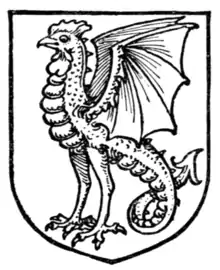cockatrice
English

A cockatrice on a coat of arms.
Etymology
First attested 1382 as Middle English cocatrice (“basilisk”), from Old French cocatriz, from Late Latin calcātrīx (“she who treads upon something”), from Latin calcō (“tread”), from calx (“heel, hoof”).
Pronunciation
- IPA(key): /ˈkɒkətɹaɪs/, /ˈkɒkətɹɪs/
Noun
cockatrice (plural cockatrices)
- (mythology) A legendary creature about the size and shape of a dragon or wyvern, but in appearance resembling a giant rooster, with some lizard-like characteristics.
- c. 1910, Joseph Walker McSpadden, The Spell of Egypt:
- “Peace reigns in happy Luxor. The lion lies down with the lamb, and the child, if it will, may harmlessly put its hand into the cockatrice’s den.”
- (obsolete) Mistress, harlot.
- (fantasy, folklore) A snake or serpent that appears to be hatched from a rooster, or cock's, egg.
- 1611, The Holy Bible, […] (King James Version), London: […] Robert Barker, […], →OCLC, Jeremiah 8:17:
- For, behold, I will send serpents, cockatrices, among you, which will not be charmed, and they shall bite you, saith the Lord.
- (speculated) The cobra. (Can we add an example for this sense?)
- (obsolete, figurative) Any venomous or deadly thing.
- 1622, Francis, Lord Verulam, Viscount St. Alban [i.e. Francis Bacon], The Historie of the Raigne of King Henry the Seventh, […], London: […] W[illiam] Stansby for Matthew Lownes, and William Barret, →OCLC:
- this little cockatrice of a king
Translations
legendary creature
|
See also
References
- For meaning "mistress": 1949, John Dover Wilson (compiler), Life in Shakespeare's England. A Book of Elizabethan Prose, Cambridge at the University Press. 1st ed. 1911, 2nd ed. 1913, 8th reprint. In Glossary and Notes
- For meaning "a snake of a chicken's egg:" 1828, Noah Webster, American Dictionary of the English language.
- For "cobra:" an article, “Cockatrice” or “Adder” in Isaiah 11:8 et al.?
Further reading
 cockatrice on Wikipedia.Wikipedia
cockatrice on Wikipedia.Wikipedia
This article is issued from Wiktionary. The text is licensed under Creative Commons - Attribution - Sharealike. Additional terms may apply for the media files.